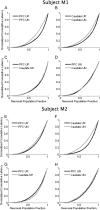Encoding of both positive and negative reward prediction errors by neurons of the primate lateral prefrontal cortex and caudate nucleus
- PMID: 22159094
- PMCID: PMC3266530
- DOI: 10.1523/JNEUROSCI.3793-11.2011
Encoding of both positive and negative reward prediction errors by neurons of the primate lateral prefrontal cortex and caudate nucleus
Abstract
Learning can be motivated by unanticipated success or unexpected failure. The former encourages us to repeat an action or activity, whereas the latter leads us to find an alternative strategy. Understanding the neural representation of these unexpected events is therefore critical to elucidate learning-related circuits. We examined the activity of neurons in the lateral prefrontal cortex (PFC) and caudate nucleus of monkeys as they performed a trial-and-error learning task. Unexpected outcomes were widely represented in both structures, and neurons driven by unexpectedly negative outcomes were as frequent as those activated by unexpectedly positive outcomes. Moreover, both positive and negative reward prediction errors (RPEs) were represented primarily by increases in firing rate, unlike the manner in which dopamine neurons have been observed to reflect these values. Interestingly, positive RPEs tended to appear with shorter latency than negative RPEs, perhaps reflecting the mechanism of their generation. Last, in the PFC but not the caudate, trial-by-trial variations in outcome-related activity were linked to the animals' subsequent behavioral decisions. More broadly, the robustness of RPE signaling by these neurons suggests that actor-critic models of reinforcement learning in which the PFC and particularly the caudate are considered primarily to be "actors" rather than "critics," should be reconsidered to include a prominent evaluative role for these structures.
Figures











References
-
- Abler B, Walter H, Erk S, Kammerer H, Spitzer M. Prediction error as a linear function of reward probability is coded in human nucleus accumbens. Neuroimage. 2006;31:790–795. - PubMed
-
- Aosaki T, Kimura M, Graybiel AM. Temporal and spatial characteristics of tonically active neurons of the primate's striatum. J Neurophysiol. 1995;73:1234–1252. - PubMed
-
- Asaad WF, Rainer G, Miller EK. Neural activity in the primate prefrontal cortex during associative learning. Neuron. 1998;21:1399–1407. - PubMed
-
- Barnes TD, Kubota Y, Hu D, Jin DZ, Graybiel AM. Activity of striatal neurons reflects dynamic encoding and recoding of procedural memories. Nature. 2005;437:1158–1161. - PubMed
Publication types
MeSH terms
Grants and funding
LinkOut - more resources
Full Text Sources
Miscellaneous
